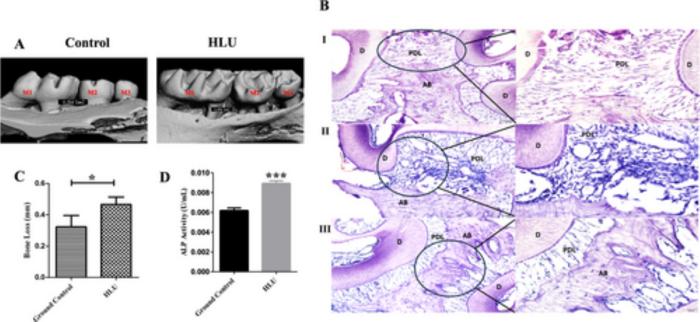Living in the harsh environment of space presents numerous health challenges, with one of the most surprising implications being the exacerbation of dental diseases. A recent study published in the Journal of Periodontal Research sheds light on how the unique conditions of microgravity may impact oral health, particularly regarding periodontitis—a serious gum disease that leads to inflammation and the breakdown of the supporting bone around teeth. Researchers delved into the intricacies of how the near-weightless environment of space might influence the development and progression of this condition, discovering alarming results that may have implications for future astronauts and long-duration space missions.
In conducting their groundbreaking research, scientists utilized a model that simulates the effects of microgravity on mice. The experimental design involved subjecting C57BL/6J mice to a condition called hindlimb unloading, which mimics the physiological changes that occur in a microgravity environment. By placing the mice in a position that restricts weight-bearing on their hind limbs, the researchers effectively created an analogous condition to what astronauts experience during space travel. Induction of periodontitis was then achieved through the placement of ligatures around specific molars, allowing for a controlled observation of disease progression in both the ground control and microgravity-simulated groups.
The study’s lead author, Professor Zahi Badran from the University of Sharjah, articulated that the results were troubling. Mice subjected to simulated microgravity exhibited significantly more severe inflammation of the gums and notable bone loss compared to their counterparts on Earth. The research team meticulously measured disease markers and tissue damage, noting a pronounced increase in immune cell presence in those affected by induced gum disease in a microgravity setting. Such findings highlight a disturbing possibility: prolonged exposure to zero gravity could severely compromise oral health, increasing the risk of systemic health issues due to chronic inflammation.
The structural assessment of the maxillary bone in the experimental subjects revealed striking differences between the two groups. Mice in microgravity conditions showed a marked increase in the distance from the cemento-enamel junction to the alveolar bone crest, indicating significant resorption of supporting structures linked to poor periodontal health. In stark contrast, those in the ground control category exhibited minimal bone loss, underscoring the detrimental effects that a lack of gravity can have on dental health.
Moreover, biochemical analyses showed heightened levels of alkaline phosphatase (ALP) activity among the space-simulated mice, a marker commonly associated with bone resorption and increased inflammatory processes associated with periodontitis. Such elevations suggest that the changes in gravity not only worsen gum disease but may also alter metabolic pathways related to bone health. The researchers believe that understanding these mechanisms could lead to the establishment of targeted dental care strategies designed specifically for astronauts.
As the future of space exploration evolves, with missions to Mars and beyond on the horizon, the implications of this research become increasingly significant. As humans embark on longer journeys into space, the health protocols administered to astronauts must encompass dental health, particularly considering the potential for increased gum disease in a microgravity environment. The authors of the study advocate for an integrated approach to health care for space travelers, ensuring that dental practitioners contribute to the overall well-being of astronauts amidst the challenges of extended space habitation.
In the wider context, this study not only sheds light on space medicine but also identifies important takeaways for terrestrial medicine. The findings could provide valuable insights into the prevalence of periodontal disease among immobilized patients on Earth—those unable to engage in weight-bearing activity due to various medical conditions. By leveraging the hindlimb unloading model, further research could unravel the biological pathways influenced by microgravity, potentially informing therapies for individuals with similar challenges in mobility.
While the current study is a pioneering effort to address the gaps in knowledge surrounding oral health in space, the researchers acknowledge its limitations. With a relatively small sample size, they stress the need for continued investigations to validate their findings and explore the intricate relationship between gum diseases and systemic health within the context of altered gravity conditions. Replication of their model will be essential for assessing additional immunological and microbiological parameters, thereby deepening the understanding of how oral disease progression occurs under the unique stresses of microgravity.
In conclusion, as we stand on the cusp of a new era in space exploration, understanding how the environment of outer space influences human health is imperative. The research presented offers crucial insights into a previously underexplored aspect of astronaut health—oral disease—underscoring the need for robust dental care protocols in forthcoming missions. This study not only paves the way for future research on dental health in space but also reaffirms the necessity of incorporating and monitoring oral health strategies in the broader scope of space medicine.
Subject of Research: Animals
Article Title: Microgravity Exacerbates Periodontitis In Vivo
News Publication Date: 13-May-2025
Web References: Journal of Periodontal Research
References:
Image Credits: Credit: Journal of Periodontal Research
Keywords
periodontal disease, microgravity, space health, oral health, astro-dentistry, bone resorption, inflammation, astronaut health, biomedical research, dental care




